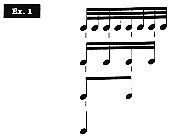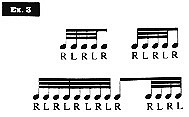Welcome to PaulWertico.com!
Skeletal Rhythms
Many drummers would love to possess the ability to play fills and rhythms that are fast, intricate, and exciting. And it's a great feeling to hear someone really go for it. This type of playing can lift the band, as well as the whole room, right off the floor. However, sometimes trying to execute such things can also cause problems in accurate placement. This, in turn, can screw up the groove, and thus cause everything to fall apart. In almost all types of music, speed without accuracy is virtually worthless. So let's look at a way to approach practicing that should give you more control and confidence in preparation for those moments of abandon.
First of all, it takes a lot of practice to acquire physical speed and control, and yet, the physical part is only half the battle. Once you're able to play fast, it's critical that you're also able to think and hear what you're playing in time. That can be a real problem. For example, if you're playing something such as a long string of thirty-second-notes, it can be quite difficult to keep your mind moving at that speed and still make sure that each thirty-second is landing accurately in time. You want to play 32 thirty-second-notes over a space that needs 32 thirty-seconds; and you don't want to play 34 or 31 "whatever notes" over the same space, unless that's what you intend to do.
So, one way to make sure that you're playing accurately is to feel slower subdivisions inside of the thirty-seconds. This will allow your mind to relax and take it all in. I call these slower subdivisions "skeletal rhythms". These are rhythms within rhythms that strengthen what you're trying to play. It's similar to the way your skeleton holds up the rest of your body. While using skeletal rhythms you should feel the slower rhythm while playing the faster one. Now take a look at Ex. 1:

You'll notice that one quarter-note equals two eighth-notes, which equals four sixteenth-notes, which equals eight thirty-second-notes. You might already know that. However, there is a musical way in which you can apply that knowledge. Look at Ex. 2a:


In 2a you find a phrase using thirty-second-notes. Some of you might have a hard time playing this, but if you look at Ex. 2b, you'll see how this sixteenth-note rhythm fits inside the thirty-second-note rhythm. I think it's a safe bet that more of you could play 2b easier than 2a. So next, try feeling 2b, and use stickings such as the ones in Ex. 3 or 4 to play 2a:


I think you'll see how much easier it is to play 2a in time by doing this. You can apply this method to any duple-based rhythm. If you're trying to play a triplet-based rhythm, such as sixteenth-note triplets, you can break it down to eighth-note triplets. Also, you don't have to apply this technique only to written notes. For example, practice playing sixteenth notes on the hi-hat or snare drum, and then drop in double strokes. You'll see how the thirty-second-notes just seem to fall into place. Next, try dropping in triple strokes. Then try combinations of doubles and triples. Let your imagination run wild. It's a great way to figure out what you really want to play and to clean up your interpretation.
Once you get used to applying this technique to playing fast rhythms, you'll be able to do it automatically. Your execution will be more accurate and you'll be able to play those "go for it" fills with much more success and confidence.
Images and Information from DRUM! March/April 1992, pages 46 & 47